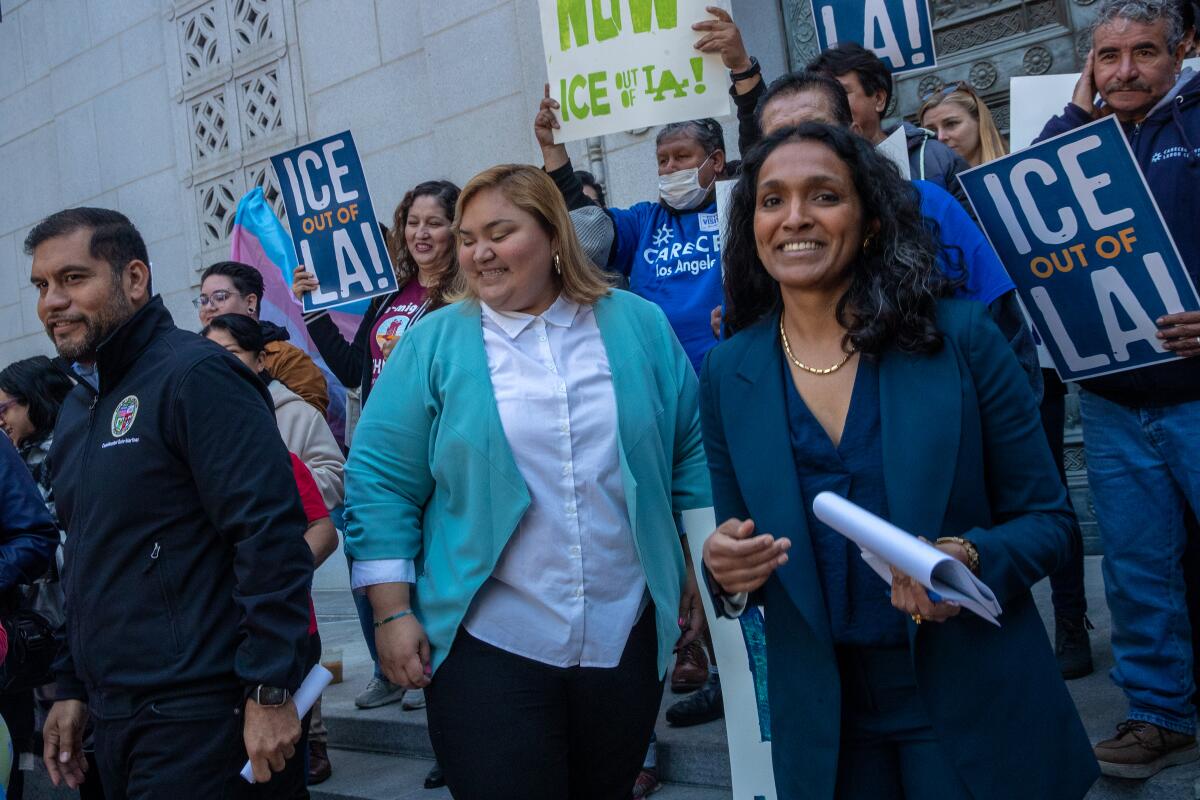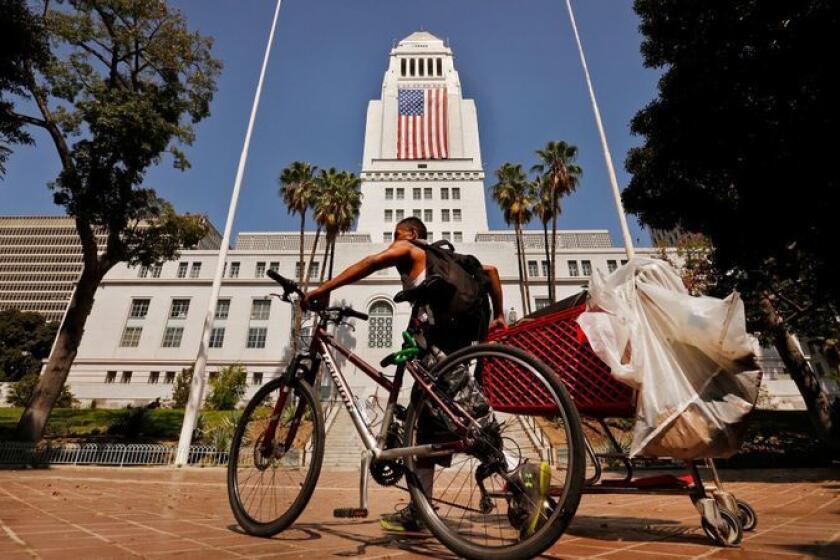3 City Council members want a law designating L.A. a ‘sanctuary city’

- Share via
Soon after President Trump took office, Los Angeles immigration groups demanded that City Hall label L.A. a haven for immigrants in the face of his promised crackdown.
The Los Angeles City Council ultimately passed a resolution that declared L.A. a “city of sanctuary” — a symbolic gesture that offered no legal protections.
Now, Councilmembers Eunisses Hernandez, Hugo Soto-Martinez and Nithya Raman want to strengthen L.A.’s laws around immigration. They announced Tuesday they would seek passage of an ordinance declaring L.A. a “sanctuary city” and barring city personnel or resources from being used in federal immigration enforcement.
If adopted, the law would be largely similar to one in San Francisco. It prohibits city employees from using city funds or resources to assist U.S. Immigration and Customs Enforcement officers in the enforcement of federal immigration laws unless such assistance is required by federal or state law.
Raman said her office worked with immigration advocates and others on the proposed law. Some of the leaders of those groups told The Times they are looking to next year’s presidential election.
It took nearly a year and a half, but officials voted Friday to declare Los Angeles a “city of sanctuary,” long after other left-leaning cities took a similar stand against the Trump administration’s policies toward immigrants who lack legal status.
Florida Gov. Ron DeSantis, a presumed Republican candidate, has made cracking down on people in the country without authorization a focus.
“We want to make sure that L.A. is ready for a worst-case scenario,” said Shiu-Ming Cheer, deputy director of programs and campaigns at the California Immigrant Policy Center.
The law sought by the three council members would codify existing policies, including a 2017 executive directive issued by then-Mayor Eric Garcetti that prohibits all city employees from using public facilities or resources to assist or cooperate with federal civil immigration enforcement.
The proposed law would also bar federal immigration authorities or other entities connected to immigration enforcement from accessing city databases or anyone’s personal data.
The proposal follows moves by the L.A. County Board of Supervisors, which in 2020 voted to ban the transfer of inmates to ICE custody unless the authorities have a judicial warrant.
The council members’ motion asks the city attorney to prepare a draft ordinance within 60 days that would prohibit, to the extent permissible by law, the use of city resources, property or personnel for any federal immigration enforcement.
Nearly 10% of the nation’s 11.1 million immigrants who are in the country without legal authorization reside in Los Angeles and Orange counties, according to a 2017 Pew Research Center report.
Speaking at a news conference Tuesday, Hernandez said it’s time that L.A. lives “up to its promise to our immigrant communities.”
“Symbolic gestures are not enough,” Hernandez said. “Internal policies that can be changed from one day to the next are not enough.”
Hernandez’s office said in a news release that the “city and internal LAPD policies still allow for ICE officers to access city jails to interrogate people in LAPD custody, and, under certain circumstances, LAPD officers are permitted to transfer individuals to ICE custody, even when judicial warrants are not issued.” The proposed ordinance seeks to limit those interactions.
The Los Angeles Police Department declined to answer questions about its policies.
The Times also sent multiple questions to ICE about its practices. In response, the agency said its operations are “focused on smart, effective immigration enforcement that protects the homeland through the arrest and removal of those who undermine the safety of our communities and the integrity of our immigration laws.”
Following Trump’s election and promise to deport migrants, mayors in Boston, Chicago and elsewhere reaffirmed their cities as sanctuaries, and the California Legislature passed a law that aims to protect immigrants.
L.A.’s efforts around establishing itself as a sanctuary have come in fits and starts. The city in 2017 set aside $2 million for a legal defense fund to pay for attorneys for individuals and families who are detained or at risk for deportation.
City leaders also introduced a resolution that year to declare L.A. a “city of sanctuary,” calling it a direct response to Trump’s efforts to unwind a program that protects immigrants brought to the U.S. illegally as children.
However, it took the city two years to vote on the resolution, and by then, immigrant advocates said, its declaration had lost significance.
President Biden has reversed some immigration policies but also faced criticism for proposals that immigration groups say would mirror Trump’s tough crackdown.
At the same time, ICE’s surveillance capabilities have expanded. The agency has worked with third-party vendors to collect data from utility companies and private databases, according to findings from a two-year investigation published last year by the Georgetown Law Center on Privacy & Technology.
For example, the report found that ICE has driver’s license data for 3 in 4 adults living in the U.S. and can track the movement of vehicles in cities that are home to nearly 75% of adults.
Albert Fox Cahn, executive director of the Surveillance Technology Oversight Project, said declarations of “sanctuary city” labels are “empty rhetoric” unless cities and counties also ensure that ICE can’t access troves of data collected by those municipalities.
Get the lowdown on L.A. politics
Sign up for our L.A. City Hall newsletter to get weekly insights, scoops and analysis.
You may occasionally receive promotional content from the Los Angeles Times.
The group has filed a lawsuit against a third-party vendor in a federal case in California.
“We encourage cities to analyze city data and how it’s being stored and whether it’s susceptible to warrants,” Cahn said.
In Los Angeles, mobility data are collected by the city, for example, Cahn said.
Los Angeles Department of Transportation spokesperson Colin Sweeney said the city receives route or drop-off and pickup information from companies that offer scooters, bicycles and some taxis in L.A. to ensure operators are following city rules. The city doesn’t gather information about riders, Sweeney said.
The department is prohibited from sharing its mobility data with law enforcement unless required by a subpoena or warrant, Sweeney said. No federal agency has ever accessed or sought access to this data, he added.
Ira Mehlman, spokesman for the Federation for American Immigration Reform, predicted that the proposal, if passed, would strain L.A.’s education and healthcare system.
“People tend to flock to areas where they know that there isn’t cooperation with federal immigration authorities,” said Mehlman, calling the proposal “costly” for taxpayers.
The phrase “sanctuary city” dates to the 1980s, when U.S. immigration policies allowed some Central American immigrants entry but not others. In response, Berkeley and a few other municipalities declared themselves “sanctuary cities” to accept those migrants.
A divided L.A. City Council adopted a resolution in 1985 declaring Los Angeles a city of sanctuary for immigrants fleeing political persecution and violence, particularly refugees from El Salvador and Guatemala.
After one council member threatened a ballot measure to overturn the resolution, the council watered it down and dropped the phrase “city of sanctuary.”
Instead, the council voted to reaffirm a policy that banned city employees from considering a person’s “refugee or residence status” before providing city services.
More to Read
Sign up for Essential California
The most important California stories and recommendations in your inbox every morning.
You may occasionally receive promotional content from the Los Angeles Times.















